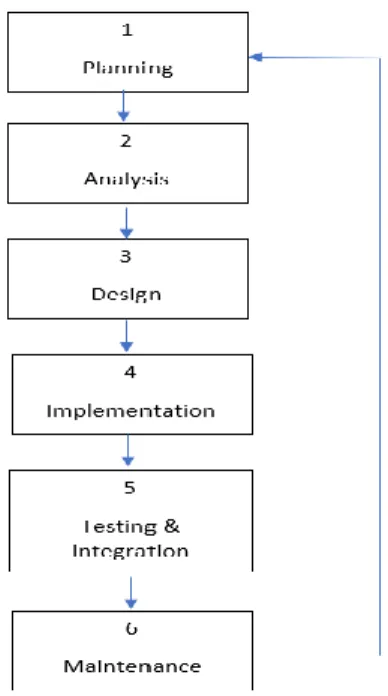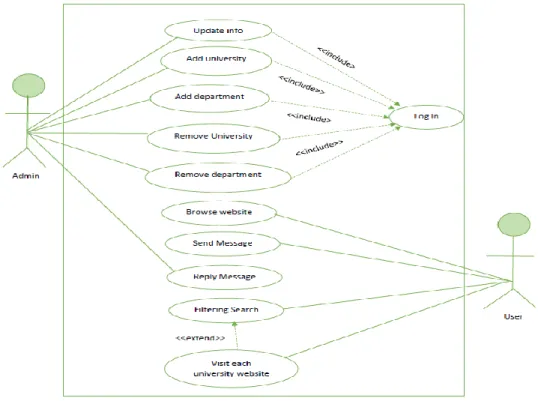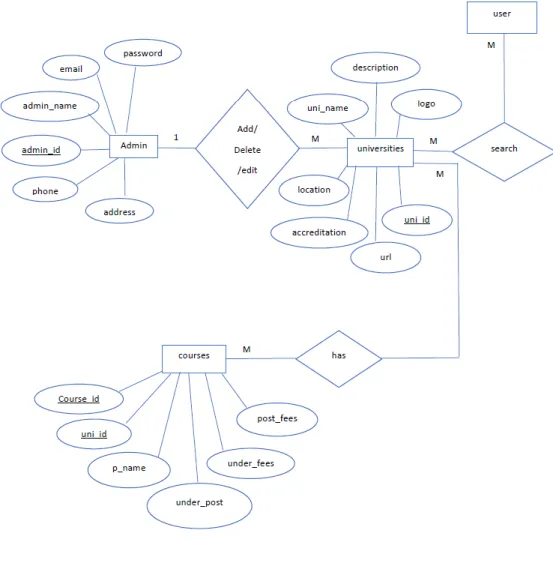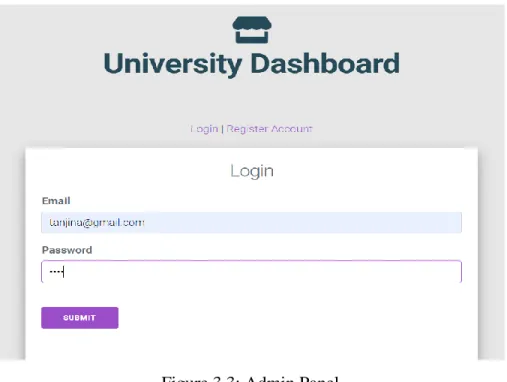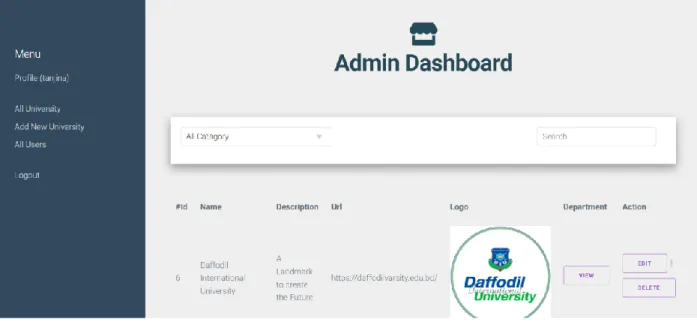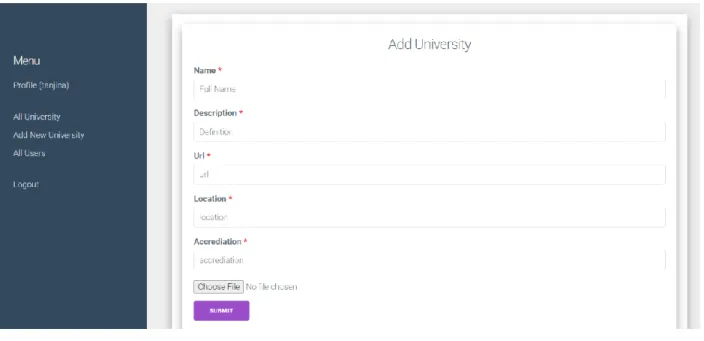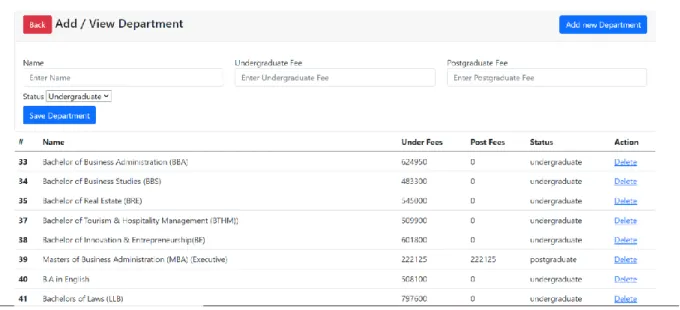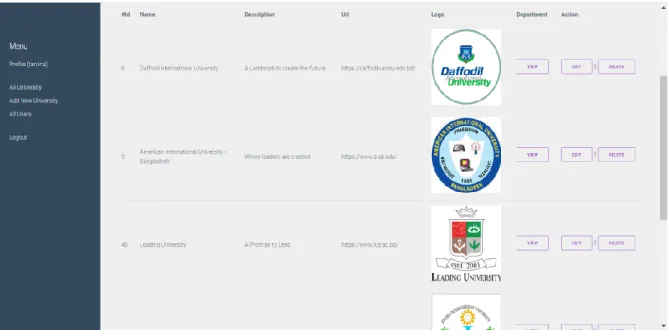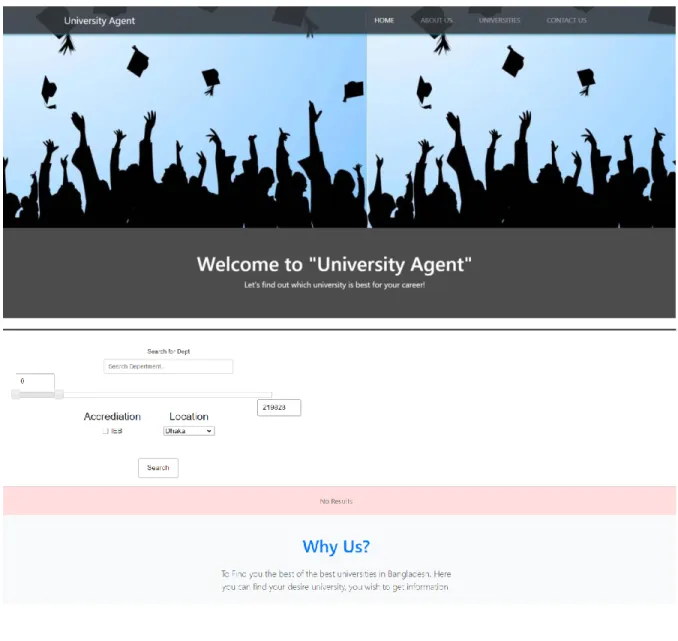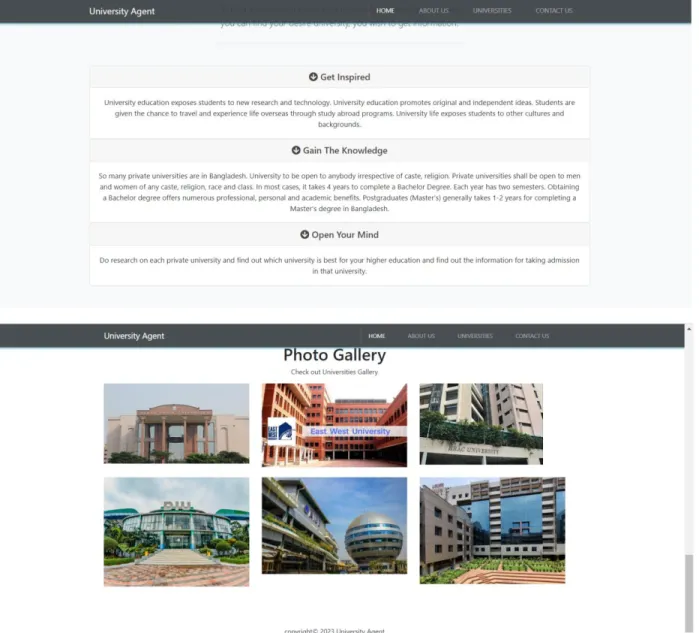“UNIVERSITY AGENT” – A WEB APPLICATION
BY
Tanjina Islam
ID: 192-15-1070 Project ID: FL21D191
This Report Presented in Partial Fulfillment of the Requirements for the Degree of Bachelor of Science in Computer Science and Engineering
Supervised By
Taslima Ferdaus Shuva Assistant Professor Department of CSE
Daffodil International University
Co-Supervised By Mohammad Monirul Islam
Assistant Professor Department of CSE
Daffodil International University
DAFFODIL INTERNATIONAL UNIVERSITY
DHAKA, BANGLADESH JANUARY, 2023
©Daffodil International University i
©Daffodil International University
ii
ACKNOWLEDGEMENT
First, I express my heartiest thanks and gratefulness to Almighty Allah for His divine blessing makes us possible to complete the final year project successfully.
I really grateful and wish my profound indebtedness to Taslima Ferdaus Shuva, Assistant Professor, Department of CSE Daffodil International University, Dhaka. Deep Knowledge
& keen interest of my supervisor in the field of “Web Application” to carry out this project.
Her endless patience, scholarly guidance, continual encouragement, constant and energetic supervision, constructive criticism, valuable advice, reading many inferior draft and correcting them at all stage have made it possible to complete this project.
I would like to express my heartiest gratitude to Professor Dr. Touhid Bhuiyan, Head, Department of CSE, for his kind help to finish my project and also to other faculty member and the staff of CSE department of Daffodil International University.
I would like to thank my entire course mate in Daffodil International University, who took part in this discuss while completing the course work.
Finally, I must acknowledge with due respect the constant support and patients of my parents.
©Daffodil International University iii
ABSTRACT
To live in today's modern world one of the most important requirements for a person is technology. Internet plays a huge role in every part of our life because almost everyone uses internet in every sphere of life. As internet is a platform of vast knowledge and information, it has become very important for education. This report includes a project that deals with developing an academic website to assist students to find their desirable university to get admission. The main purpose of this project is to smoothen the way to find preferable university with comparison to other universities sitting at comfort zone of ones’ through internet. This website is very easy to use and well organized. It provides the user with a search facility to find the specific university directly or go through all the listed universities respectively. Users can easily know about the offered program by each university and the cost per program, and also where it located. Students can also send messages to the admin for any query. My project includes the private universities of Bangladesh only. The system is implemented using HTML, CSS, Bootstrap, Java Script and PHP programming language with MySQL relational database.
©Daffodil International University iv
TABLE OF CONTENTS
CONTENTS PAGE
Board of examiners i
Declaration ii
Acknowledgements iii
Abstract iv
CHAPTER
CHAPTER 1: INTRODUCTION
1-21.1 Introduction 1
1.2 Motivation 1
1.3 Objectives 2
1.4 Research questions 2
1.5 Expected Outcome 2
CHAPTER 2: BACKGROUND
3-52.1 Introduction 3
2.2 Software Development Life Cycle 3
2.3 Challenges faced during Development 5
CHAPTER 3: REQUIREMENT SPECIFICATION
6-83.1 Introduction 6
3.2 Use-Case diagram and Description 6
3.3 ER diagram 7
3.4 Design Requirement 8
3.4.1 Authorization Requirement 8
3.4.2 Application Security 8
3.4.3 Admin Panel 8
9-17
©Daffodil International University
CHAPTER 4: DESIGN SPECIFICATION
9-194.1 Front-end Design 9
4.1.1 Design Methodology 9
4.2 Back-end Design 10
4.2.1 Description of the Database Design 10
4.3 User Experience (UX) 10
4.4 About Database 10
4.4.1 Admin Dashboard 10
4.4.2 Add Universities 11
4.4.3 Add Department 12
4.4.4 All Universities 12
4.5 Final Output 13
4.5.1 Home page 13
4.5.2 About page 15
4.5.3 Filtering search 15
4.5.4 University page and details 16
4.5.5 Contact Us page 17
4.5.6 Send Message 17
4.5.7 Admin received message by mail 18
4.5.8 Replying the message 18
4.6 Implementation requirements 19
CHAPTER 5: MAINTENANCE PLAN
205.1 Maintenance and Sustainability Plan 20
CHAPTER 6: CONCLUSION AND FUTURE PLAN
216.1 Conclusion 21
6.2 Future Plan 21
REFERENCES
22PLAGIARISM RESULT
23©Daffodil International University
LIST OF FIGURES
FIGURES PAGE NO
Figure 2.1: Phases of SDLC 3
Figure 3.1: Use case diagram 6
Figure 3.2: ER diagram 7
Figure 3.3: Admin panel 8
Figure 4.1: Admin dashboard 11
Figure 4.2: Add university 11
Figure 4.3: Add department 12
Figure 4.4: All university 12
Figure 4.5: Home page 13-14
Figure 4.6: About page 15
Figure 4.7: Filtering search 15
Figure 4.8: University page and details 16
Figure 4.9: Contact us 17
Figure 4.10: Send message 17
Figure 4.11: Received message 18
Figure 4.12: Replying to message 18
©Daffodil International University
CHAPTER 1 Introduction
1.1 Introduction
The World Wide Web and the Internet are growing more quickly than they have in the previous decades. With the advancement and enhancement of computer science and engineering, Internet technology and database technology are now used widely. Today, the emerging trend of using Internet every stage of education to get information or find solution has ensured the development of a whole new line of assisting platform where everyone can access to all kind of information with a click of a button. The revolution that started a few years ago has spread very quickly. People these days have chosen to use the internet to stay informed about the surrounding environment. It is difficult for students mainly who are from rural area to go to urban universities to collect information. Whereas nowadays we all are internet savvy users so we can be aware of all the information staying home by using internet. Academic website is a promoted online environment which is built for educational institutions to provide information about the education, learning opportunities, the offered programs, mentioning cost and where it located. This ‘University Agent’ website is an academic website having these facilities.
1.2 Motivation
In last 2 years we all globally faced very critical period due to the pandemic of Covid-19.
In a pandemic situation like covid-19, it was challenging enough to go outside and visit universities physically because of lockdowns and collect information regarding admission.
And it is not easy for the students to come and visit all the private universities of their choice. Delay in university admission could hamper the thirst for learning of students. As this is the era of information and communication technology, all private universities have its own academic website but I thought of making a platform where the information of all
©Daffodil International University 1
the private universities of our country can be found together and students can easily find their suitable university by comparing and using filter search.
1.3 Objectives
• To design and implementation of an academic website that allows access to all.
• To facilitate the search program.
• To create a separate section for the undergraduate and postgraduate program offer list of the listed universities.
• Create a message sending option for any queries.
1.4 Research questions
During the planning phase of this project, many questions and difficulties emerged which are the basic research questions of this project. These following challenging questions, help to focus on the main expectations for this project-
1. How can I organize this website?
2. Weather users will be required to log in or not?
3. Can students search university with cost range?
4. Should I keep the graduation and post-graduation programs separately with cost?
5. Is it easy to collect the information or not?
1.5 Expected Outcome
All internet users can easily access to the website and collect information about the universities. User can send message if he/she has any query. This new website pattern can save a lot of time and energy for students.
©Daffodil International University 2
CHAPTER 2 Background
2.1 Introduction
The history of the project is analyzed in this chapter. I've been trying to develop a website University Agent to represent the private university information. To build this, it requires several details. We need to follow several guidelines or protocols to create a project. To develop a website, a range of technologies need to be researched and understood. These include-
2.2 Software Development Life Cycle
Software Development Life Cycle (SDLC) describes the sequence of phases or steps to develop any software. It is a necessary activity for planning, improving, evaluating, and sustaining software of performance in the software industry. It explains how particular software can be created, maintained, replaced, and improved. The following figure-2.1 shows the various phases of the life cycle of software development.
Figure 2.1: Phase of SDLC
©Daffodil International University 3
Stage 1: Planning and Requirement Analysis
Planning and requirement analysis is the most vital and fundamental stage in SDLC.
Project developers arrange a survey to collect the results. This information is then used to plan the basic project approach. Before starting a project, a fundamental understanding of the project is very critical.
Stage 2: Analysis and defining
Once the requirement analysis is done the next step is to record and approve software specifications by the project stakeholders.
Stage 3: Designing the project architecture
A design approach clearly defines the architectural components of the product along with its communication and data flow representation.
Stage 4: Implementation
In this SDLC phase, the actual development starts and product is built. The programming code is generated in this stage. Code generation may be completed quickly if the design is done in a precise and systematic manner.
Stage 5: Testing & integration the product
Following the completion of the project, the major step testing comes where product defects are reported, tracked, fixed and retested. These activities are mostly involved in all the stages of SDLC.
Stage 6: Maintenance
After testing the product, it is formally ready to be release. Then based on the feedback its maintenance is done for the users.
©Daffodil International University 4
2.3 Challenges faced during Development
For this project, I have to learn many things like HTML, CSS, Bootstrap, PHP and Database.
As a learner, I have to overcome many challenges such as-
1. When I started my project, I had to start with HTML, CSS, and Bootstrap. Although I began using these technologies and the CSS framework, I must first become familiar with them.
2. When I started to develop Front-end, I had faced problem to do layout with HTML, CSS, and Bootstrap.
3. Working on the back-end was quite difficult for me as I had never done this type of project before.
4. I had to learn how to search and filter data using PHP and MySQL database.
©Daffodil International University 5
CHAPTER 3
Requirement Specification
3.1 Introduction
The purpose, functions, and behavior of a website or other software product are described in a requirement specification document. In other words, it defines what the website is for, how it would work and what it should do. My “University Agent” project is also subject to the same requirements.
There are several operating systems available such as iOS is quite widely known with Windows, Linux, Mac, and Android. Therefore, a certain operating system can use the web application, but a regular internet connection is needed.
3.2 Use-Case diagram and Description
Use-case diagrams clarify, illustrate and organize system requirements. The use case is mainly made up for setting the possible sequences of interactions between systems and users. This diagram shows what the system does and how the users use it.
Figure 3.1: Use-case diagram
©Daffodil International University 6
3.3 ER Diagram
The entity-relationship diagram (ERD) shows the connections between the sets in a database.
In this definition, an entity is an object or a piece of data. A set of entities is a collection of connected entities. They could possess traits that define their qualities. By outlining the bodies, their characteristics, and the links between them, databases' conceptual structure is made clear.
Using ER diagrams, my project database has been constructed.
Figure 3.2: ER diagram
©Daffodil International University 7
3.4 Design Requirements
3.4.1 Authorization Requirement
Anybody will browse the platform as a website. So, no permission is needed. However, the admin panel must need permission. Users require the internet and an internet browser to run the system.
3.4.2 Application Security
Cyber risks are currently increasing. So, on the website, there should be many safeguards against cyberthreats. One is database stable.
1. Encrypt the database to prevent illegal access.
2. Only admins can access the dashboard.
3.4.3 Admin Panel
The administrator has a significant impact on this procedure. The site information may be accessed and changed by the administrator. Fees for the programs offered by the university are variable and may be kept up to date by the admin. When a registered admin wants to log in to admin panel it gets validate with PHP validation. A person cannot login to admin panel without registration. So first he needs to register himself as admin.
Figure 3.3: Admin Panel
©Daffodil International University 8
CHAPTER 4 Design Specification
4.1 Front-end Design
A well-designed website helps to make a positive impression on potential clients. But more significantly, it gives website visitors a positive user experience and makes it easier for them to access and browse the website.
The principles of good website design - 1. User-friendly design
2. Mobile responsiveness 3. Friendly and clear navigation 4. Add the right pages
5. Everything is easy to use or access 6. Calls-to-action
7. Design should fulfill its intended function 8. Maintain standards for design.
4.1.1 Design Methodology
For my website design I used the following design tools of websites-
HTML which is a markup language is the most extensively used Frontend Language.
Cascading Style Sheets (CSS) is a style sheet language how HTML elements are to be displayed. And also Bootstrap which is the most popular CSS framework for developing responsive websites. t offers a collection of syntax for template designs and includes HTML, CSS, and JS-based scripts for diverse web design features
.
©Daffodil International University 9
4.2 Back-end Design
4.2.1 Description of the Database Design
Database architecture is a database model organization of records. The database developer decides which data needs to be handled and how the data should be organized in the structure.
Based on this understanding, the data will begin to be employed in a database model. The management of all records is one of database administration's primary duties.
4.3 User Experience (UX)
Strong architecture may attract customers. To have the best UX interface, any of the principles must be followed. They are given below-
• Useful
• Valuable
• Required
• Searchable
4.4 About Database
4.4.1 Admin Dashboard
The following figure showing the Admin Dashboard. The administrator dashboard mainly presents all the data and information that the system was designed to collect and arrange. This dashboard enables administrators to quickly and easily manage communities by giving them direct access.
©Daffodil International University 10
Figure 4.1: Admin Dashboard
4.4.2 Add Universities
The figure showing the add university page. Here admin can add information regarding a university name, uni logo, description, location, university website url.
Figure 4.2: Add university
©Daffodil International University 11
4.4.3 Add Department
The following figure shows how admin can add department, fees with the department status which mentions is the department is for undergraduate or postgraduate.
Figure 4.3: Add department
4.4.4 All universities
The following figure-4.4.6 is showing the All universities section where we can add universities and department and also can edit information or delete it.
Figure 4.4: All universities
©Daffodil International University 12
4.5 Final output
4.5.1 Home Page
The following figure-4.5.1 presents the Home Page which is the main page of a website.
This page usually contains the links of the other pages of the website.
Figure 4.5: Home page
©Daffodil International University 13
Figure 4.5: Home page of the website
©Daffodil International University 14
4.5.2 About page
The about page explains the purpose of creating this website.
Figure 4.6: About page
4.5.3 Filtering search
The following figure showing the university in Dhaka where CSE department is available between 5 to 9 lakhs.
Figure 4.7: Filtering search
©Daffodil International University 15
4.5.4 University page and details
Figure 4.8: University page and details
©Daffodil International University 16
4.5.5 Contact Us page
If students have any queries they can send message to admin through this contact us page
.
Figure 4.9: Contact Us
4.5.6 Send Message
Messages send to admin through mail
Figure 4.10: Send message
©Daffodil International University 17
4.5.7 Admin received message by mail
Figure 4.11: Received message
4.5.8: Replying to messages
Figure 4.12: Replying the message
©Daffodil International University 18
4.6 Implementation requirements
To build this web application I used the following mentioned infrastructure and technical specifications.
1. VS code (visual studio code) is a code editor with support for development operation.
2. HTML & CSS used for the architecture of the web application.
3. Bootstrap is the free and open-source front-end framework.
4. MySQL is used as Database Administrator. MySQL is a database management system that is included in the PHP framework.
5. JavaScript is used to make the website interactive and dynamic.
6. PHP is a widely-used scripting language geared toward web development. It allows web developers to create dynamic content and interact with databases.
©Daffodil International University 19
CHAPTER 5 Maintenance Plan
5.1 Maintenance and Sustainability Plan
In the present situation, the majority of people choose internet solutions for their day-to- day problems. Users will appreciate how convenient, pleasant, and efficient this system is.
Therefore, this initiative is meant to last. Some components of this project, including the database, front end, and back end, will be modified to improve website management and user happiness. In the project, the privacy of the user’s information, which is collected with their consent, must be protected and kept secured. Therefore, to increase its sustainability, this project also needs regular updates. Also the web maintenance is essential in order to make sure that my website is achieving its purpose.
©Daffodil International University 20
CHAPTER 6
Conclusion and Future Plan
6.1 Conclusion
The more digital we become the easier our lives become. The main benefit of the internet is that it provides instant access to a wealth of knowledge. By using this website, students can choose the university and department of their choice according to their affordability and considering the fees. Through this system students can avoid the hassle they have to go through before taking admission in the university.
6.2 Future Plan
As resources are limited, there are always some limitations to a project. By adding simple features from time to time, it can turn into a huge project with a big database. I attempted to solve the first milestone. More features can be added to make this website more powerful and more useful such as-
1. Plan is to add the rest of the private universities of Bangladesh.
2. Planning for the direct admission through this website.
3. Adding a payment option for the students who can directly collect admission form from the chosen University listed in this web application.
4. Opening profile about this web application on social media and giving regular updates.
5. Strengthening the privacy and security of the system to enable the project’s rapid expansion.
©Daffodil International University
21
References
1. System Development Life Cycle, available at
https://www.tutorialspoint.com/sdlc/sdlc_overview.htm 2. SDLC stages, available at
https://www.softwaretestinghelp.com/software-development-life-cycle-sdlc/
3. Use case diagram, available at
https://www.visual-paradigm.com/guide/uml-unified-modeling-language/what-is- use-case-diagram/
4. Learn about MySQL, available at
https://www.w3schools.com/php/php_mysql_intro.asp 5. Learn about PHP, available at
https://www.w3schools.com/php/
6. Studied for building a web application, available link
https://www.netsolutions.com/insights/how-to-build-a-web-app/
©Daffodil International University 22
Plagiarism Result
©Daffodil International University 23
